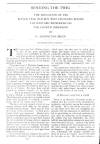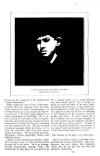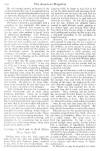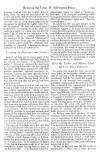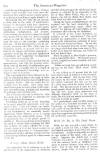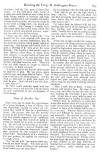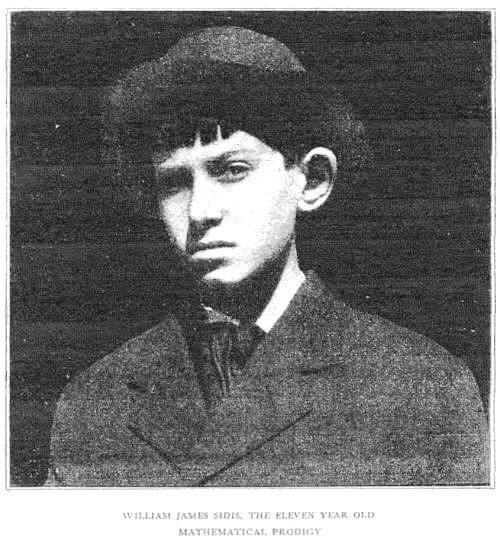| Archives
Home Bio W.J.
Sidis
Click to enlarge.
Two years ago Prof. William James, in one of the most remarkable articles ever published in this or any other periodical, formulated for the readers of THE AMERICAN MAGAZINE his startling psychological doctrine of the hidden energies of man. “Everyone knows,” Professor James wrote, “what it is to start a piece of work, either intellectual or muscular, feeling stale―or cold, as an Adirondack guide one put it to me. And everybody knows what it is to ‘warm up’ to his job. The process of warming up gets particularly striking as the phenomenon known as ‘second wind’. On usual occasions we make a practice of stopping an occupation as soon as we meet the first effective layer (so to call it) of fatigue. We have then walked, played, or worked ‘enough’, so we desist. . . . But if an unusual necessity forces us to press onward, a surprising thing occurs. The fatigue gets worse up to a critical point, when gradually or suddenly it passes away, and we are fresher than before. “We have evidently tapped a level of new energy, masked until then by the fatigue-obstacle usually obeyed. There may be layer after layer of this experience. A third and a fourth ‘wind’ may supervene. Mental activity shows the phenomenon as well as the physical, and in exceptional cases we may find, beyond the very extremity of fatigue-distress, amounts of ease and power that we never dreamed ourselves to own, sources of strength habitually not taxed at all, because habitually we never push through the obstruction, never pass those early critical points . . . “It is evident that our organism has stored-up reserves of energy that are ordinarily not called upon, but that may be called upon: deeper and deeper strata of combustible or explosible material, discontinuously arranged, but ready for use by anyone who probes so deep, and repairing themselves by rest as well as do the superficial strata. Most of us continue living unnecessarily near our surface.” The controversy which these views of Professor James provoked still waxes warm. For the most part his scientific colleagues are at odds with him. Yet all the time, while his critics have been criticising him, facts have been coming to light tending to prove that Professor James’s theory, far from being a gospel of overstrain, is a gospel of hope, opening up to the human race vistas of possibilities and achievement unreached in any epoch of the history of the world. A Marvel―and Still a Child There is at Harvard University today a student who has caused much astonishment, perplexity, and debate among the members of the faculty. He is only eleven years old. At an age when most boys are struggling desperately with the elementals of education, this lad is specializing in advanced mathematics, and, since admission at the beginning of the college year last September, has easily held his own with fellow students in most cases more than twice his age. Even before coming to Harvard he had progressed far on the road towards mastery in the science of mathematics. Algebra, trigonometry, geometry, differential and integral calculus―all these he had at his fingers’ ends by the time he was nine or ten. He has even written a treatise on the properties of the hypothetical “fourth dimension.”
What makes the case of this child-undergraduate still more amazing is the fact that, unlike almost every other “infant prodigy” of whom history gives any account, his marvelous precocity is far from being confined to a single department of knowledge. He is almost as good an astronomer as he is a mathematician, and for the past few months has been industriously charting the heavens according to a new system of his own. He has invented a universal language which, he clams, is free from the objections that have been raised against Esperanto. He has studied anatomy, physiology, physics, geography, history, and political science. Withal, he has remained essentially a child. He is as truly a boy as is the barefoot urchin playing ball in the street. He is no bulging-browed, bespectacled, anaemic freak. His cheeks have a ruddy glow, his eyes sparkle, he has a ringing laugh, and is fairly bubbling over with animal spirits. He is, in fact, so much of a boy that when, at the age of eight, his parents entered him in a high school, the school authorities, at the end of three months, were glad to see the last of him, so damaging to the discipline of the classroom were his pranks and antics. In some respects he is more childlike than the average youngster of his years and has not yet outgrown his fondness for the toys of the nursery. Of this, as of his wonderful intellectual attainments, I can speak from long personal observation, as I have known him since he was seven. The Father of the Boy―and His Ideas How to account for him is a problem that is puzzling the savants of Harvard. One man, however, the boy’s father, feels absolutely certain that he can give the true and only adequate information. His son’s mental growth, he declares, is the result not of heredity, not of exceptional native talent, but of a special education he has received, an education having as its chief purpose the training of the child to make facile, habitual, and profitable use of his hidden energies. The father is himself a psychologist with a reputation on two continents. His name is Boris Sidis. Although best known in the scientific world as a medical psychologist, he has for years been making a special study of educational psychology. Like Professor James, with whom he is a co-discoverer of the law of latent energy, a subject on which Dr. Sidis has been working and experimenting for years, he is firmly convinced that most of us “live unnecessarily near the surface,” and he throws the blame for this largely on our educational system. In particular, he condemns the custom of delaying any attempt at formal education of the child until he arrives at “school age.” “The notion that the young child’s mind should be allowed to lie fallow,” is the way Dr. Sidis put it to me, “is utterly wrong and pernicious. The child is essentially a thinking animal. No power on earth can keep him from thinking, from using his mind. From the moment his inquiring eyes first take in the details of his surroundings he begins the mental processes which education is intended to guide and develop. He observes, he draws inferences from everything he sees and hears, he seeks to give expression to his thoughts. “Left to himself, however, he is certain to observe inaccurately and to make many erroneous inferences. Unless he is taught how to think he is sure to think incorrectly, and to acquire wrong thought habits, causing him to form bad judgments respecting matters not only vital to his own welfare but also important to the welfare of society. In fact, in order to get the best results, his training in the principles of correct thinking should begin as soon as, or even before, he starts to talk. There need be no fear of over-taxing his mind. On the contrary, the effect will be to develop and strengthen it, by accustoming him to make habitual use of the latent energy which most people never utilize at all.” Learning to Spell and to Read Before Three Years Old Holding these views, Dr. Sidis, upon the birth of his son―who was named William James Sidis, after Professor James―resolved to put them to the test of experiment. To realize his great aim of energizing and rationalizing the child, he began to train him in the use of his observational and reasoning faculties before he was two years old, and, with the aid of a box of alphabet blocks, actually succeeded in teaching him how to spell and read before he was three. He did this by playing with the boy, shifting the alphabet blocks around to spell different words, pointing to the objects spelt, and naming them aloud. The effect of this was not simply to teach the child spelling and reading, but also to give him a thorough grounding in the principles of sound reasoning. Moreover, the method employed by Dr. Sidis seemed to impart to his son a power of mental concentration seldom seen in children. All children, as every parent is aware, are eager “tom know about things,” but as a rule their inquisitiveness is easily satisfied, and they flit, like so many butterflies, from one subject to another without giving much thought to anything. Not so with little William James Sidis. Once his attention was arrested, his interest aroused, he was not content until he had learned the exact nature of whatever had excited his curiosity. At the age of three and a half, for example, he chanced one day to wander into his father’s office while Dr. Sidis was writing a letter on a typewriter. He watched the movement of the carriage back and forth, he heard the clicking of the types, the ringing of the bell, and forthwith tugging at his father’s coat. What was that machine for, he demanded, how did it work, and many other questions. Then, climbing into his father’s lap, he pressed his little fingers on the keys, and exultantly read the words his father showed him how to form. This first lesson was followed by others, until within six months―when he was only four years old―he was typewriting with considerable dexterity. He had already learned to write with a pencil. When he was six―his parents having in the meantime removed from New York, where he was born, to Brookline, Mass.―he was sent to a public school. His career there was brief but spectacular. In half a year he passed through seven grades, leaving behind him a succession of bewildered, wide-eyed teachers, aghast at the precocity he displayed. An interval of two years of study at home was followed by three months of attendance at the Brookline High School. Then two years more of study at home, and now, as has been said, he is a special student at Harvard, toying with vector analysis and other forms of higher mathematics. At Harvard, as may be imagined, his career is being watched with the liveliest interest. Aside from the surprise occasioned by his proficiency in the difficult field of study which he has selected, those who have come into contact with him are most deeply impressed by the manner in which he, so to speak, takes himself for granted. He does not seem to regard his precocity as anything out of the usual, and enters as a matter of course into the new life opened up to him by his admission to the university. He is a regular attendant at the Harvard Mathematical Club, and enters freely into the discussion of the various papers read, his criticisms commanding as respectful a hearing as though coming from a man of mature years. Lecturing to Professors and Others Indeed, not long ago he read a paper of his own before the Mathematical Club, taking as his subject the theme, “Four-Dimensional Bodes.” As may be imagined, the attendance at that meeting of the club was the largest of the year. More than 75 men were present―professors, assistant professors, instructors, students, and some specially invited guests. Not a few came in a profoundly skeptical frame of mind, having heard about the boy, but believing that his powers had been greatly overrated. Before the evening was at an end they were listening to him with the most intense interest and evident astonishment. Many of them were quite unable to follow his complicated calculations, which he made with assurance and ease. As he explained, in opening his lecture, the “space” with which we are acquainted is of three dimensions, but it is quite conceivable that there may be space with more than three dimensions―with four, five, or any number of dimensions. In four-dimensional space it would be possible to construct mathematical figures of very different form from our ordinary three-dimensional figures. The explanation of how many of these figures there might be, how they could be constructed, and what they looked like, was the subject of his lecture. For upward of an hour and a half this little lad in knickerbockers held the closest attention of his auditors, now speaking directly to them, now reading from a carefully prepared paper, with not a little oratorical effect, and now, in a childish scrawl, demonstrating on a blackboard the mathematical proof of the theories he was advancing. As he explained it, figures in the fourth dimension could be of the most remarkable shapes, having even as many as six hundred sides. A six-hundred-sided four-dimensional figure he called a “sextacosiahedragon,” a bit of original terminology which he surpassed when he referred to another many-sided four-dimensional figure as a “hecatonicosahedragon.” In conclusion, this youngest lecturer in the annals of Harvard insisted that it was a great mistake to suppose, as do many non-mathematicians, that the hypothesis of the fourth dimension is of no practical value. On the contrary, it is of the greatest usefulness to mathematicians, who by its aid are enabled to solve many problems that would otherwise baffle them, and more particularly geometrical problems. And all this, be it remembered, is, according to his father, the result of special education, having as its principal object the training of the boy to utilize those hidden energies which, as Professor James pointed out in his AMERICAN MAGAZINE article, the vast majority of people never make any use of whatever. How the Father and Mother Managed the Boy’s Education To attain this object Dr. Sidis has, in the main, relied on the familiar educational principle of teaching a child through appealing to his interest, but he has made the appeal to interest in an unusual way―namely, by systematic application of the influence of that little understood but tremendously powerful psychological factor, “suggestion.” Now, suggestion is no mysterious or uncanny force, operable only under exceptional conditions. Everybody knows what is meant by a “suggestive teacher,” a “suggestive book,” a “suggestive picture.” By suggestion is meant nothing more than the intrusion of an idea into the mind with such skill and power that it dominates and, for the moment, disarms or excludes all other ideas which might prevent its realization. In dealing with little children, as many educators have long recognized, the one sure way of implanting in their minds the ideas which one wished to make dominant is by arousing their curiosity and stimulating their interest. This has led to the method of education through play, as exemplified in the kindergarten. But Dr. Sidis believed that, if properly manipulated, the method of education through play might be extended to subjects not taught in the kindergarten―that, in fact, a child might be led to undertake and continue the study of any subject provided it were made sufficiently interesting to him. Today, as we have seen, his son excels in mathematics. There was a time, however―while he was at the grammar school―when no subject could possibly have been more distasteful to him, and he seemed totally unable, or at all events unwilling, to apply himself to it. Discovering this, Dr. Sidis did not attempt to drive him to the study of mathematics. Instead he purchased some toys―dominoes, marbles, etc.―with which he invented games requiring more or less knowledge of addition, subtraction, multiplication, and division. Every evening, for an hour or more, he played these games with his little son, deftly managing matters so that his interest in time shifted from the toys to the principles underlying their use. In the boy’s presence, too, he continually discussed with Mrs. Sidis―who has throughout loyally co-operated with her husband in his unique educational experiment―questions involving the practical application of arithmetic and “suggesting” its importance in the affairs of every-day life. This process proved so effectual that the boy spontaneously, and with the greatest enthusiasm, took up the study of mathematics, progressing in it so rapidly that in a couple of years his mathematical knowledge was superior to that of his father. The same method has been followed by Dr. Sidis in stimulating him to the study of other subjects to which he first showed indifference or positive dislike. And the result has invariably been the same. Once really interested he has gone at every subject with eagerness and enthusiasm, grasping and mastering its principles with amazing ease. Nor is this the only way in which Dr. Sidis has made use of suggestion to stimulate his son’s intellectual development. Everything about us, as is now beginning to be pretty generally appreciated, is of suggestive. From our friends, our books, the very pictures on our walls, from everything in our environment, we constantly receive suggestions which influence us to a varying but nonetheless unmistakable extent. This is particularly true of the plastic period of childhood. Recent psychological investigation has made it certain that everything the child sees or hears, no matter whether he is consciously aware of it or not, leaves a more or less profound impression, is “subconsciously” remembered by him, and may at times exercise a determining influence upon the whole course of his life. A Story About Helen Keller One impressive bit of testimony as to the permanence of the impressions of childhood and their influence upon the child’s later development is afforded by an experience in the life of Miss Helen Keller, who, as is well known, was left by illness deaf, dumb, and blind when less than two years old. Among the many accomplishments she has acquired not the least astonishing is her power for appreciating music, which she “hears” by placing her hand lightly on the instrument and receiving its vibrations. It occurred to Dr. Louis Waldstein, an authority on the “subconscious,” that quite possibly her appreciation of music was connected with subconscious memories of music she had heard before her illness. To test this theory he obtained from her mother copies of two songs which nhad often been sung to Miss Keller as an infant in Alabama, but which she had not heard since. These he played in Miss Keller’s presence, with remarkable effect. She became greatly excited, clapped her hands, laughed, and communicated: “Father carrying baby up and down, swinging her on his knee! Black Crow! Black Crow.” It was evident to all present that she had been drawn back in memory to the surroundings of her infancy. But no one knew what she meant by the words “black crow” until her mother explained that that was the title of a third song which her father used to sing to her. She had not heard it since her nineteenth month, when she lost all sense of hearing, but now, many years afterwards and although dependent solely on the sense of touch, she was able not merely to remember it, but even to recall its name! As a psychologist―and, for that matter, as the author of a standard textbook on “The Psychology of Suggestion”―Dr. Sidis was well aware of the possibility of so arranging his son’s environment as to cause it to radiate upon him suggestions quickening and enlarging his intellectual capacities. With the Boy in His Study Room While the boy was still a mere infant, he set aside a room for him, a bright, cheery, well-lighted apartment, hung with a few attractive pictures. A little writing table was placed in one corner of the room, with pad and pencil. Opposite the child’s bed a small bookcase was placed. It was filled in part with the ordinary books of childhood―volumes of nursery rhymes, fairy tales, picture books. But it also held books of serious interest, simple tales of travel, of history, of science, and the like, most of them illustrated. As the child grew older, books of a more advanced character were added to his little library, studies in literature and biography, mathematical and scientific text-books. A large revolving globe, showing the countries of the world in bright colors, was placed near the window. Toys having a scientific basis also found a way to his room, which thus became a sort of educational museum, inspiring him with a love for knowledge. “And,” says Dr. Sidis, emphatically, “it is because he has been inspired with such an interest, such a genuine enthusiasm, that he has made the progress which people regard as surprising. Any normal child would make as good a showing if he were given the same training. The trouble is that parents neglect their children―allow them to fritter away their energies, to acquire habits of loose and incorrect thinking, at the very time when they stand most in need of careful education. It is the first years that count for most. Then it is that the child should be taught to observe accurately, to think correctly. “I do not mean by this that the child should be deprived of play. My boy plays―plays with his toys, and plays with his books. And that is the key to the whole situation. Get the child so interested in study that study will truly be play. Don’t tell me it can’t be done. I have done it.” Dr. Sidis would probably speak with less assurance were it not that this is by no means his only experiment in the development of latent energy. Story of Another Boy Some years ago he made the acquaintance of a young foreigner, a boy of fifteen, who was desperately anxious to secure an education that would fit him for a professional career. His parents, who had but recently arrived in the United States, were very poor, and were bitterly opposed to his “ambitious notions,” believing that instead of going to college he should set to work to earn his living. He had had no schooling in his native land, knew scarcely a word of English, and was ignorant of even the elementary knowledge possessed by the youngest primary-school child. Nevertheless, with a confidence that was pathetic, he applied for admission to a high school. “No,” he was told, “we cannot admit you. You do not know enough. You must go first to a primary school and then to the grammar school before you can enter here.” He was in despair when Dr. Sidis sent for him. “You wish to get into the high school, I hear,” said he. “Very well, you shall. Go and find out exactly what they require you to know before they will admit you, and then come back to me.” For hours daily he labored with the boy, teaching him first of all the rudiments of spelling, reading, and arithmetic by methods which “trained him to use his mental faculties correctly and to use them fully.” The result was much the same as achieved in his son’s case. At the end of eight months the young foreigner passed with flying colors an examination for admission to the high school. He completed the high-school course with phenomenal rapidity, graduating with the highest honors. Then he entered college, where he again distinguished himself, and, passing to a medical school, won further laurels there. Today he is holding a responsible public position. In another case the subject of experiment was a man of forty, a tailor by trade. Dr. Sidis became interested in him on learning that, in a dim, vague, inchoate way, he had longings not merely to better himself but to be of some service to humanity. He talked with the man and found that, although rather stupid and uneducated, being scarcely able to read, he was really stirred by altruistic ambitions. “Then I took him in hand. I began to educate and energize him. He came to me every day, and when he was not with me he was studying the text-books I gave him to read. I kept him at work, with his mind set on the distinct goal of helping his fellow man. “Before long, he displayed an intellectual ability that amazed those who had known him before the process of energizing began. He seemed, as some of his friends said to me, to be a new man. Whereas before he had been timid and diffident he became self-assertive and masterful. He attended and even organized workingmen’s clubs, he developed a marked gift as a public speaker, and before his death, which occurred a few years ago, won considerable reputation as a labor leader. “But I could have done much more with him had I had him much earlier. It is by beginning in early childhood that the best results can be obtained. You know the old saying―’As the twig is bent the tree’s inclined.’ Parents cannot too soon begin the work of bending the minds of their children in the right direction, of training them so that they shall grow up complete, efficient, really rational men and women.”
|
